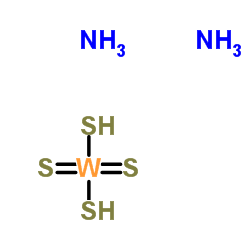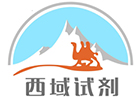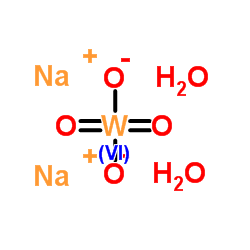四硫代钨酸铵, ≥99.9% trace metals basis,Ammonium tetrathiotungstate
产品编号:西域试剂-WR363047| CAS NO:13862-78-7| MDL NO:MFCD00061410| 分子式:(NH4)2WS4| 分子量:348.18
本网站销售的所有产品仅用于工业应用或者科学研究等非医疗目的,不可用于人类或动物的临床诊断或者治疗,非药用,非食用,
| 英文名称 | Ammonium tetrathiotungstate |
|---|---|
| CAS编号 | 13862-78-7 |
| 产品密度 | 2.71 g/mL at 25 °C(lit.) |
| 精确质量 | 347.907928 |
| PSA | 148.26000 |
| LogP | 2.70520 |
| 稳定性 | 遵照规定使用和储存则不会分解。 |
| 储存条件 | 密闭于阴凉干燥环境中 |
相关文档
化学品安全说明书(MSDS)
下载MSDS质检证书(COA)
相关产品
| 符号 |

GHS07 |
|---|---|
| 信号词 | Warning |
| 危害声明 | H315-H319-H335 |
| 警示性声明 | P261-P305 + P351 + P338 |
| 个人防护装备 | dust mask type N95 (US);Eyeshields;Gloves |
| 危害码 (欧洲) | Xi |
| 风险声明 (欧洲) | R36/37/38 |
| 安全声明 (欧洲) | S26-S37/39 |
| 危险品运输编码 | UN 3335 |
| WGK德国 | 3 |
|
Section 1: Product Identification Chemical Name:Ammonium tetrathiotungstate (VI), 99% (99.9+%-W) CAS Registry Number:13862-78-7 Formula:(NH4)2WS4 EINECS Number:none Chemical Family:metal tungstate Synonym:Ammonium thiotungstate (VI)
Section 2: Composition and Information on Ingredients IngredientCAS NumberPercentACGIH (TWA)OSHA (PEL) Title compound13862-78-7100%1g/m3 (as W - soluble)no data Section 3: Hazards Identification Emergency Overview:Dust is irritating to eyes, skin and respiratory tract. May be harmful if swallowed. Primary Routes of Exposure:Ingestion, Inhalation of dust. Eye Contact:Irritating to eyes. May cause redness and pain. Skin Contact:Mildly irritating to skin. May cause itching and redness. Inhalation:Inhalation of dust can lead to irritation of the respiratory tract, causing coughing and sore throat. Ingestion:No information on the physiological effects of ingestion. Acute Health Affects:Irritating to skin, eyes and respiratory tract. Chronic Health Affects:No information available on long-term chronic effects. NTP:No IARC:No OSHA:No SECTION 4: First Aid Measures Immediately flush the eyes with copious amounts of water for at least 10-15 minutes. A victim may need Eye Exposure: assistance in keeping their eye lids open. Get immediate medical attention. Wash the affected area with water. Remove contaminated clothes if necessary. Seek medical assistance if Skin Exposure: irritation persists. Remove the victim to fresh air. Closely monitor the victim for signs of respiratory problems, such as difficulty Inhalation: in breathing, coughing, wheezing, or pain. In such cases seek immediate medical assistance. Seek medical attention immediately. Keep the victim calm. Give the victim water (only if conscious). Induce Ingestion: vomiting only if directed by medical personnel. SECTION 5: Fire Fighting Measures Flash Point:not applicable Autoignition Temperature:none Explosion Limits:none Extinguishing Medium:None. Material is non-combustible. If this product is involved in a fire, fire fighters should be equipped with a NIOSH approved positive pressure Special Fire Fighting Procedures: self-contained breathing apparatus and full protective clothing. Hazardous Combustion andIf involved in a fire, choking fumes of sulfur dioxide may form. Decomposion Products: Unusual Fire or Explosion Hazards: No unusual fire or explosion hazards. SECTION 6: Accidental Release Measures Spill and Leak Procedures:Small spills can be mixed with powdered sodium carbonate or ground limestone and swept up. SECTION 7: Handling and Storage Handling and Storage:Store the material in a tightly sealed container in a cool, dry place. SECTION 8: Exposure Controls and Personal Protection Eye Protection:Always wear approved safety glasses when handling a chemical substance in the laboratory. Skin Protection:Wear protective gloves and clothing. Ventilation:Material may form a fine dust. If possible, handle the material in an efficient fume hood. If ventilation is not available a respirator should be worn. The use of respirators requires a Respirator Respirator: Protection Program to be in compliance with 29 CFR 1910.134. Ventilation:Material may form a fine dust. If possible, handle the material in an efficient fume hood. Additional Protection:No additional protection required. SECTION 9: Physical and Chemical Properties Color and Form:yellow to orange xtl. Molecular Weight:348.18 Melting Point:no data Boiling Point:no data Vapor Pressure:not applicable Specific Gravity:no data Odor:rotten egg odor Solubility in Water:1g/15cc (turbid solution) SECTION 10: Stability and Reactivity Stability:air and moisture stable Hazardous Polymerization:no hazardous polymerization Conditions to Avoid:reaction with mineral acids Incompatibility:Strong oxidizing agents and mineral acids Decomposition Products:ammonia, nitrogen oxides, sulfur dioxide and tungsten compounds. SECTION 11: Toxicological Information RTECS Data:No information available in the RTECS files. Carcinogenic Effects:no data Mutagenic Effects:no data Tetratogenic Effects:no data SECTION 12: Ecological Information Ecological Information:No information available SECTION 13: Disposal Considerations Disposal:Dispose of according to local, state and federal regulations. SECTION 14: Transportation Shipping Name (CFR):Non-hazardous Hazard Class (CFR):NA Additional Hazard Class (CFR):NA Packaging Group (CFR):NA UN ID Number (CFR):NA Shipping Name (IATA):Non-hazardous Hazard Class (IATA):NA Additional Hazard Class (IATA):NA Packaging Group (IATA):NA UN ID Number (IATA):NA SECTION 15: Regulatory Information TSCA:Not listed in the TSCA inventory SARA (Title 313):Title compound not listed Second Ingredient:none SECTION 16 - ADDITIONAL INFORMATION N/A |
|
~82% 
13862-78-7 |
| 文献:Drew, Michael G. B.; Hobson, Richard J.; Mumba, Peter P. E. M.; Rice, David A.; Turp, Neil Journal of the Chemical Society, Dalton Transactions: Inorganic Chemistry (1972-1999), 1987 , p. 1163 - 1168 |
| 上游产品 2 | |
|---|---|
| 下游产品 1 | |











 浙公网安备 33010802013016号
浙公网安备 33010802013016号